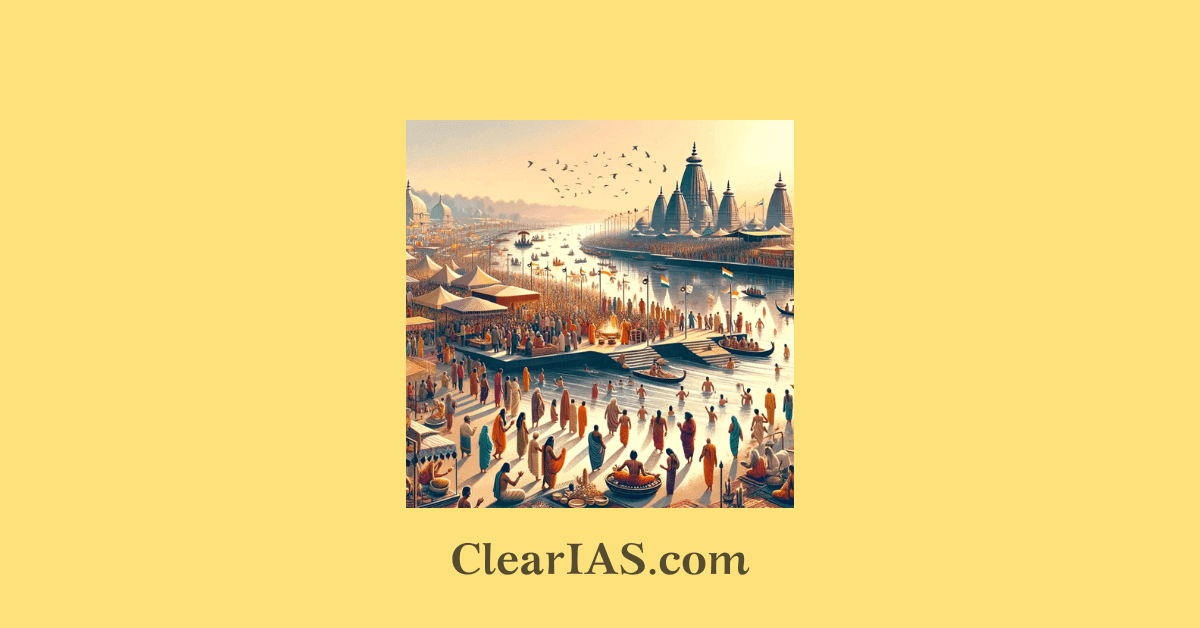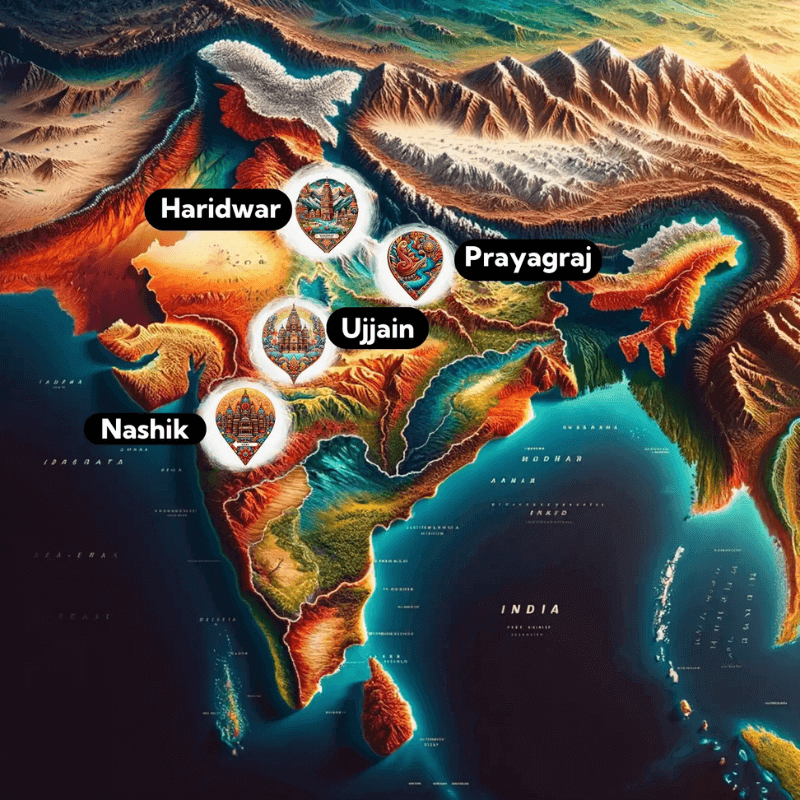
The Maha Kumbh Mela is a significant Hindu religious festival and pilgrimage, often considered the largest human gathering on Earth. Kumbh occurs every 12 years at four different locations in India: Prayagraj (Allahabad), Haridwar, Ujjain, and Nashik. Read here to learn more.
The Maha Kumbh Mela 2025, a sacred pilgrimage, will be held in Prayagraj from 13th January to 26th February 2025, drawing millions of pilgrims for spiritual purification, cultural celebration, and unity.
This sacred event rotates between four locations in India-Haridwar, Ujjain, Nashik, and Prayagraj- each situated by a holy river, from the Ganges to the Shipra, the Godavari, and the confluence of the Ganges, Yamuna, and the mythical Sarasvati in Prayagraj.
The Maha Kumbh Mela is celebrated at a particular site once every 144 years -12 cycles of the 12-year Kumbh Mela.
Maha Kumbh mela
The Maha Kumbh Mela is celebrated when specific planetary alignments occur, and it is believed to have immense spiritual significance. It is considered a time for the purification of sins through bathing in sacred rivers.
At the confluence of the Ganges, Yamuna, and the mythical Sarasvati rivers, known as Triveni Sangam, millions of devotees gather to perform this deeply significant ritual.
The act of immersing in these holy waters is believed to purify one of the sins, liberate both individuals and their ancestors from the cycle of rebirth, and ultimately guide them towards Moksha, or spiritual liberation.
Historical Significance
- Mythological Roots: The festival draws from the Puranas, where the gods and demons churned the ocean (Samudra Manthan) to retrieve Amrit (nectar of immortality). Four drops of nectar are believed to have fallen at the current Kumbh locations.
- Ancient Period: The festival’s significance grew during the Maurya and Gupta empires (4th century BCE to 6th century CE), reflecting Hinduism’s growing prominence.
- Medieval Era: Dynasties like the Cholas and Vijayanagara kings supported it. Akbar promoted its inclusivity, granting ceremonial honours to sadhus.
- Colonial Period: British observers like James Prinsep documented the Mela’s cultural and spiritual significance.
- Modern Recognition: Post-independence, the Kumbh Mela has symbolized India’s cultural unity. It was recognized by UNESCO in 2017 as part of the intangible cultural heritage of humanity.
Locations and Cycle

- The festival rotates among the four locations based on planetary alignments:
- Prayagraj (Sangam): Confluence of the Ganga, Yamuna, and mythical Saraswati.
- Haridwar: Banks of the Ganga.
- Ujjain: Along the Shipra River.
- Nashik: On the banks of the Godavari River.
- Every 12 years, the Kumbh Mela takes place at a specific location, with an Ardh Kumbh Mela occurring every six years.
Different Types of Kumbh
- Purna Kumbh Mela: Held every 12 years at each of the four locations.
- Ardh Kumbh Mela: Celebrated every 6 years, alternating between Haridwar and Prayagraj.
- Maha Kumbh Mela: Occurs every 144 years (12 cycles of the 12-year Kumbh Mela), exclusively at Prayagraj.
- Magh Kumbh Mela: An annual event celebrated in the month of Magh (January-February) at Prayagraj.
Rituals of Kumbh Mela
The rituals and activities associated with events like the Maha Kumbh Mela highlight the rich spiritual, cultural, and historical significance of Hindu traditions.
Shahi Snan (Royal Bath)
- Significance: This ceremonial bath is considered the most auspicious ritual of the Kumbh Mela. Depending on the location of the Kumbh, it is performed in sacred rivers such as the Ganges, Yamuna, or Godavari.
- Procession: Saints and monks from different Akharas (spiritual organizations) arrive in grand processions for the bath. This ritual symbolizes the purification of sins and is believed to lead to moksha (salvation).
- ‘Rajyogi Snan’: This alternate name reflects the regal and sanctified nature of the ritual.
Akharas and Their Origins
- The word “Akhara” is derived from “Akhand,” meaning indivisible or eternal, representing unity and spiritual steadfastness.
- Established by Adi Guru Shankaracharya in the 8th century to unify ascetic organizations, Akharas aim to safeguard the Sanatan Dharma (eternal tradition).
- Types of Akharas:
- Shaiva Akharas: Devoted to Lord Shiva.
- Vaishnava Akharas: Worship Lord Vishnu.
- Udaseen Akharas: Associated with Chandra Dev, Guru Nanak’s son, focusing on a blend of Sikh and Hindu philosophies.
Peshwai Processions
- These grand processions showcase the Akharas’ arrival in royal style. Participants ride on elephants, horses, or chariots, adorned with traditional ornaments and flags.
- The processions exemplify the grandeur of Hindu traditions, attracting thousands of spectators and devotees.
Spiritual Discourses and Cultural Activities
- Saints and spiritual leaders deliver discourses on Hindu philosophy, ethics, and the essence of dharma.
- Cultural Events:
- Performances of Indian music and dance.
- Exhibitions of crafts and traditional art that reflect India’s spiritual heritage.
UNESCO Recognition
- The Kumbh Mela was recognized as an Intangible Cultural Heritage of Humanity by UNESCO in 2017, acknowledging its spiritual and cultural significance.
Kumbh 2019: Guinness World Records
- Largest traffic and crowd management plan.
- The biggest painting exercise of public sites under the Paint My City Scheme.
- Biggest sanitation and waste disposal mechanism.
Challenges and Management
- Given its massive scale, the festival requires meticulous planning for crowd management, sanitation, security, and healthcare.
- Modern technologies, including drones, AI, and real-time monitoring systems, are increasingly being used to manage logistics and ensure safety.
Upcoming Maha Kumbh Mela
- The next Kumbh Mela is scheduled to take place in Prayagraj in 2025, with preparations already underway to accommodate the expected influx of millions of devotees.
Conclusion
The Maha Kumbh Mela exemplifies India’s cultural and spiritual vibrancy, showcasing devotion, community participation, and heritage on an unparalleled scale.
Previous year questions
Q. Safeguarding the Indian art heritage is the need of the moment. Discuss (Mains 2018)
Q. With reference to the religious history of India, consider the following statements: (Prelims 2020)
- Sthaviravadins belong to Mahayana Buddhism
- The Lokottaravadin sect was an offshoot of the Mahasanghika sect of Buddhism
- The deification of Buddha by Mahasanghikas fostered Mahayana Buddhism
Which of the statements given above is/are correct?
(a) 1 and 2 only
(b) 2 and 3 only
(c) 3 only
(d) 1, 2 and 3
Q. With reference to Manipuri Sankirtana, consider the following statements: (Prelims 2017)
- It is a song and dance performance
- Cymbals are the only musical instruments used in the performance
- It is performed to narrate the life and deeds of Lord Krishna
Which of the statements given above is/are correct?
(a) 1, 2 and 3
(b) 1 and 3 only
(c) 2 and 3 only
(d) 1 only
Q. With reference to India’s culture and tradition, what is ‘Kalaripayattu’? (Prelims 2014)
(a) It is an ancient Bhakti cult of Shaivism still prevalent in some parts of South India
(b) It is an ancient style bronze and brass work still found in the southern part of the Coromandel area
(c) It is an ancient form of dance-drama and a living tradition in the northern part of Malabar
(d) It is an ancient martial art and a living tradition in some parts of South India
Frequently Asked Questions (FAQs)
Q. When was the last Kumbh Mela held?
Ans: The 2013 Kumbh Mela was the largest religious gathering in the world with almost 120 million visitors. An Ardh Kumbh Mela was held in early 2019.
Q. When was the last Maha Kumbh mela held?
Ans: The last Maha Kumbh Mela was held in 2001. The next Maha Kumbh Mela, which is held every 144 years, is expected to take place in the 22nd century.
-Article by Swathi Satish





Leave a Reply